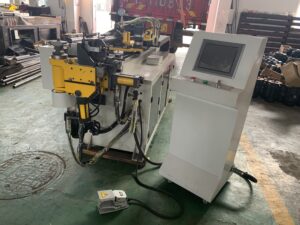In the realm of metalworking and manufacturing, pipe bendings to precise shapes is a critical task. Two primary tools used for this purpose are manual pipe benders and automatic pipe benders.

1. Operation Method
Manual Pipe Bender:
- Hands-On Approach: Manual pipe benders require physical effort from the operator. They use a lever or crank to apply force to bend the pipe around a die or mandrel. The operator adjusts the bend radius and angle manually, often using gauges or templates to achieve the desired specifications.
- Flexibility: While manual bending allows for a high degree of control and flexibility in shaping pipes, it is time-consuming and labor-intensive.
Automatic Pipe Bender:
- CNC Control: Automatic pipe benders utilize computer numerical control (CNC) technology to automate the bending process.
- Precision: CNC technology ensures high precision and consistency in bend dimensions, reducing the risk of errors and improving the quality of the finished product.
2. Productivity and Efficiency
Manual Pipe Bender:
- Lower Throughput: Manual bending is slower, typically suitable for small production runs or one-off projects. The time required to bend each pipe is significantly longer compared to automatic methods.
- Operator Skill: The efficiency of manual bending depends heavily on the skill and experience of the operator.
Automatic Pipe Bender:
- Higher Throughput: Automatic pipe benders can handle larger production volumes more efficiently.
- Reduced Labor Costs: While the initial investment in an automatic pipe bender is higher, it can lead to significant cost savings over time by reducing labor costs and increasing production output.
3. Cost and Initial Investment
Manual Pipe Bender:
- Lower Initial Cost: Manual pipe benders are generally less expensive than their automatic counterparts.
- Maintenance: Manual benders typically require less maintenance, as they have fewer moving parts and are less prone to breakdowns.
Automatic Pipe Bender:
- Higher Initial Cost: Automatic pipe benders are more expensive due to their advanced technology and higher degree of automation. They require a significant initial investment but can justify their cost through increased productivity and reduced waste.
- Maintenance: Automatic benders require more sophisticated maintenance due to their complex machinery. Regular servicing and calibration are necessary to ensure optimal performance and longevity.

4. Application and Use Cases
Manual Pipe Bender:
- Ideal for: Manual pipe benders are often used in situations where flexibility and adaptability are crucial. They are well-suited for prototyping, small-batch production, and applications requiring intricate or unique bend shapes.
- Suitable Materials: They can handle a variety of materials, including stainless steel, copper, and aluminum, but may struggle with thicker or harder materials.
Automatic Pipe Bender:
- Ideal for: Automatic pipe benders excel in high-volume production runs where consistent quality and precision are paramount. They are ideal for industries such as automotive, aerospace, and construction where large quantities of pipes need to be bent to exact specifications.
- Suitable Materials: They can handle a wide range of materials, including mild steel, stainless steel, and exotic alloys, with high precision and repeatability.




